Three years ago we bought land in Latvia, in the village of Amatciems, well-known in narrow (or maybe not so much) circles. Since then we regularly go there from Moscow. Now we will travel even more often, because we are finally starting to build a house :) We tried to get to Latvia in all possible ways: by plane, by train, and now we almost always go by car. It’s cheaper, more convenient, plus we need a car on site to solve various household and construction issues.
| An endless line of trucks on the Russia-Latvia border |
Globally, there are two ways to get by car from Moscow to Riga (we will conventionally assume that we are going exactly there, although we turn a little and don’t get there).
Method one: along the Moscow-Riga highway
Most “newbies” travel to Latvia this way. We also drove along this route for the very first time. It was so long ago that we didn’t really remember what exactly we really didn’t like, but we remembered that we really didn’t like it. Either the endless potholes on the roads in the most inappropriate places, or the fact that while crossing the border we managed to watch one and a half films...
A week ago, when it was once again time to travel by car from Latvia to Russia, we decided to refresh our memories - fortunately, a girl came to the guest house where we are staying in Amatciems who traveled exactly along this route and praised her very much.
And off we went.
Now I can safely say that the main problem of the Moscow-Riga highway (and back) is not potholes or customs at all. The road was really repaired, it is smooth almost everywhere, and at customs we were the first, and although the Russian border guards found fault more than the Latvian and Belarusian ones combined, everything went fine. The main problem of the Moscow-Riga highway is that it is single-lane along its entire LENGTH. And this is horror, horror, considering the number of trucks that use this road. Even if you are quite happy with driving at a speed of 80 km/h behind some truck driver, you will almost certainly have to overtake a couple of times, because there will certainly be someone ahead who is going 60 km/h, or even a tractor. My husband can't stand trucks in front of him, so he overtakes a lot, a lot. And on this highway it is dangerous, because the road almost always twists and goes uphill.
But the worst thing is that the trucks move in columns, leaving no space between them even for a passenger car. I don’t know what’s in these people’s heads. And so you find a more or less flat section of the road, you go out to overtake, as it seems to you, one truck (you can’t see the others), and there are three, or even five of them... There’s nowhere to go - you screw up as best you can, and then time, another truck comes around the corner to meet you (which is not bad, because they don’t drive), or a car, which is worse, because they can rush at under 200.
During the trip there were three moments in which I really said goodbye to life. The last time, when we barely got away from the truck - literally, as they show in the films, it was so scary that I pressed myself all the way into the right door (instinctively away from the collision), then I shook for a long time.
And then there was another case when a car had already entered our lane - and did not think of turning back, forcing us to fly to the side of the road. Luckily, there was a curb there.
Let me note that we were driving on a sunny summer day, that is, the visibility was excellent and it was light. How scary it must be to drive along this highway in the rain and how many accidents there are in winter - it’s scary to imagine.
My husband doesn’t agree with my opinion, he thinks that everything is okay and that I’m panicking in vain. In vain or not - well, look at the statistics of accidents on the Moscow-Riga highway :) And we must remember that in almost any oncoming collision one of the participants is not to blame. That is, even if you are driving perfectly, the likelihood that someone will decide to overtake the truck and not calculate their strength is very high.
Why would anyone even drive on this highway? You ask.
Firstly, they simply don’t know that there is another way.
Secondly, so quickly and directly.
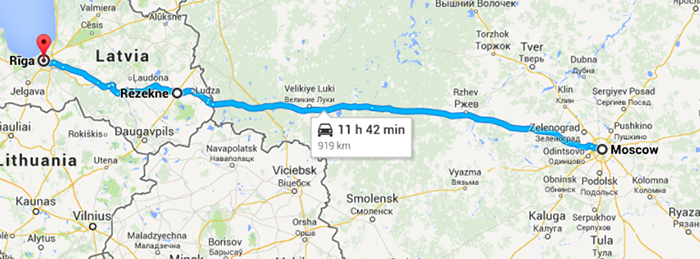
Control points: Odintsovo - Mozhaisk - Volokolams - Rzhev - Velikiye Luki - border with Latvia - Rezekne - Jekabpils - RigaFrom the center of Moscow to the center of Riga - 919 km, on average 13 hours
Method two: through Belarus
Our neighbors in the guest house in Amatciems once told us about this method. You probably wouldn't have thought of it yourself. Because going through Belarus means making a rather long detour of about 300 kilometers.
Why lengthen the road so much? Because it gives you the opportunity to drive on luxury roads. The road will almost always be two-lane, smooth, without potholes or repairs, straight, in general - gorgeous. If you come across a truck, calmly change lanes to the left and go around.
In those places in Belarus where the road does become single-lane, there will be a very wide and flat shoulder, and all slow-moving traffic will drive along it or move to the side of the road to let you pass. It's always very nice :)
One of the not obvious advantages: on this route there are several places where you can eat really tasty and very inexpensive food. There are either no such places on the Moscow-Riga highway, or we just can’t find them, there are eateries in the spirit of “heating up a hamburger that has been in the freezer for 100 years for a truck driver, he doesn’t need any more.”
Most often we eat at the Seli-Poeli restaurants in the village of Ermaki, still on the Russian side, in front of Smolensk. The only drawback is that they don’t accept cards, but otherwise it’s delicious, large fresh portions, not expensive.
As for the border, then this moment as such, there is no Russia-Belarus border, that is, there is a point, sometimes there is even someone standing there, but you don’t even need to stop at it - just slow down.
We are always the first at the Belarus-Latvia border and have never stood in line. The entire border is usually crossed (more precisely, driven) in half an hour.
Anchor points: Odintsovo - Mozhaisk - Vyazma - Yartsevo - Krasnaya Gorka (border with Belarus) - Vitebsk (detour) - Shumilino - Novopolotsk - Verkhendvinsk - border with Latvia - Kraslava - Preili - Jekabpils - Plavinas - Riga
From the center of Moscow to the center of Riga - 1,060 km, drive approximately 15-16 hours, observing the speed limit in Europe and exceeding no more than 20 km in Russia (80 at populated areas, 110 on the highway).
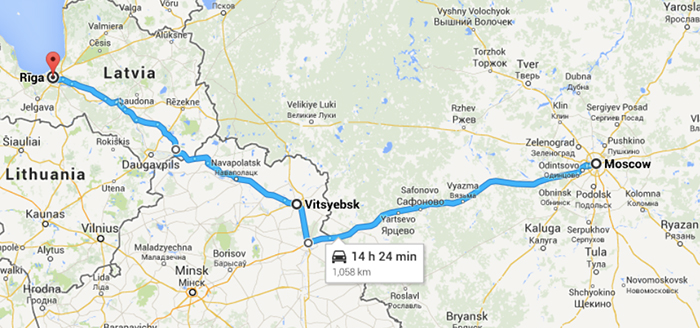
If you need to go specifically from Moscow to Riga, I wouldn’t even think about it - and would go through Belarus. A difference of 100 kilometers is not worth the risk of a head-on collision on the Moscow-Riga highway.
In our case, since we are going not to Riga, but to Amata (near the city of Cesis), the detour turns out to be more significant - almost 300 kilometers. With an average consumption of 9 liters per 100 km, our Mazda consumes 2,700 rubles per trip if we go through Belarus, and 1,400 rubles if along the Moscow-Riga highway. At the same time, we get from Moscow to Riga three to four hours faster. But is three or four hours and a little over a thousand rubles worth saving of a potential threat to life? I’m sure no, that’s why we won’t travel between Moscow and Riga anymore, we’ll travel through Belarus :)
Moreover, there is such beauty on both sides!
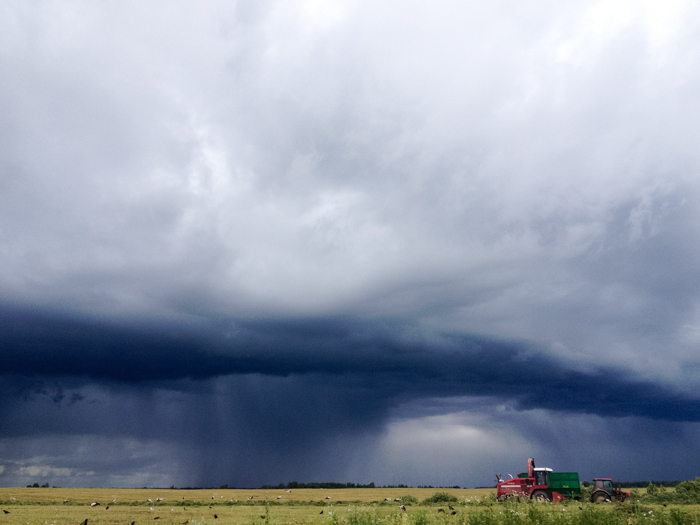
Our journey began on May 6, 2015 in the evening, the team consisted of 4 people, 2M and 2F:)
We planned to leave around 21:00 Moscow time, but due to certain circumstances we left Moscow at 22:30.
The route on the map is not the one we took; we adjusted it a little in the process, but overall it is close to the truth.
I would like to note right away that it deserves special praise federal highway M1 (Belarus), both from Moscow and to Moscow, is a gorgeous highway, with perfect coverage, bump stops, lighting - that’s why it was decided to drive through Belarus, and not through New Riga. Unfortunately, not a single road will save everyone from the mass return to the metropolis on the last day May holidays(but more on that at the end of the story).
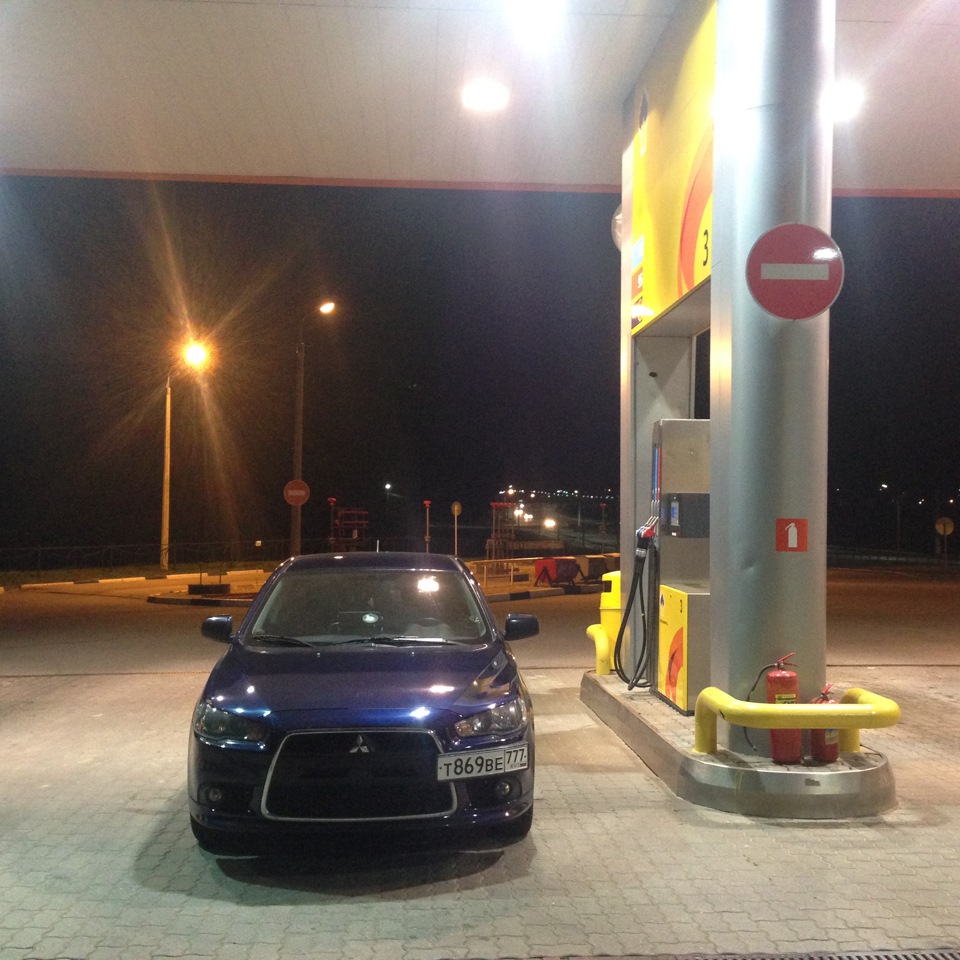
In the Smolensk area we left the M1 for Vitebsk, the road became worse, but remained in good condition, we crossed the Russia-Belarus border at a speed of 40 km/h. After the border, the road deteriorated, road repairs, detours, bumps, holes, etc. began.
After Vitebsk there was a stunning sunrise, we couldn’t help but stop and photograph it

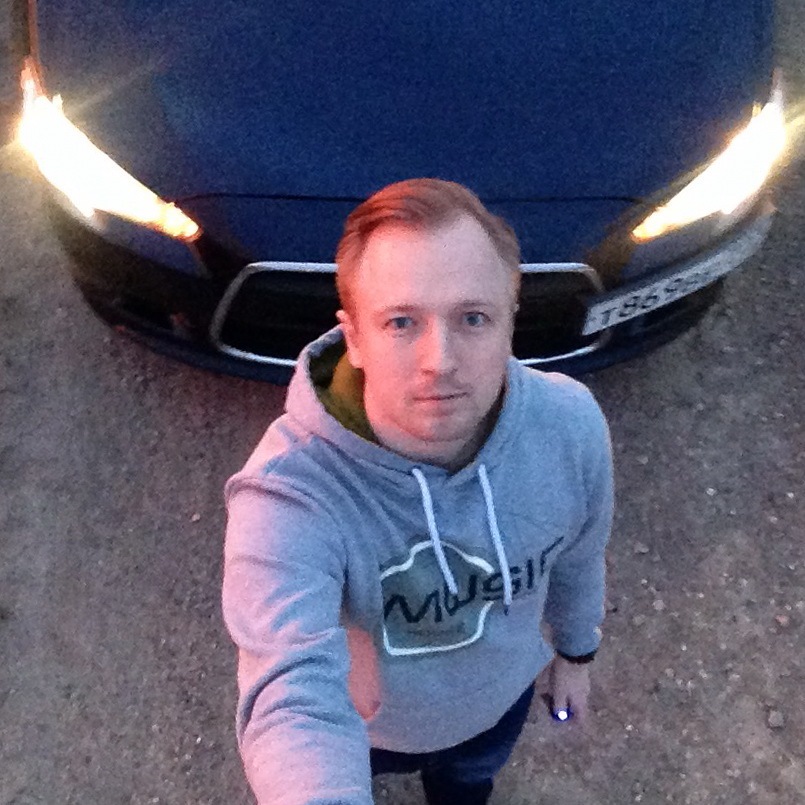
and a car :)
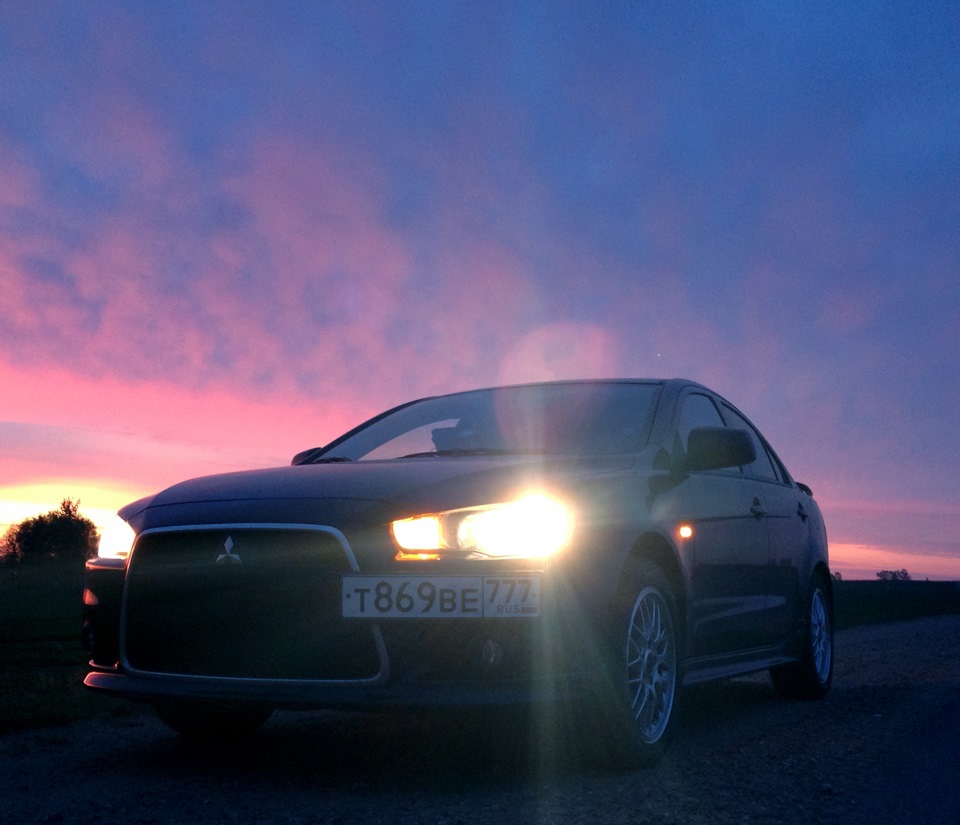
You can cross the Belarus-Latvia border moving through Vitebsk in two places: 1. Paternieki-Grigorovshchina 2. Urbany-Silene. We chose the second option because... according to stories seasoned travelers throughput this point is higher, and fewer cars go there. Plus small bonuses when crossing the border in this place - a little less than 10 km before the border (in front of the city of Urbany) there is a gas station, which allows you to fill up to a full tank and not spend money on expensive Latvian gasoline (we drove on one tank from the border to the coast and back).


A short stop. By this point, it was the 8th hour of travel and a night of driving, which was preceded by a working day without sleep.
When we arrived at the border we were delighted, we were second. We arrived at the border at 8:40, i.e. 10 hours after departure. It should be taken into account that at this time the border guards have a shift change, which should last 15 minutes, but in fact it takes longer until everyone sits down, logs into the computer, and collects their thoughts. At least half an hour. The Belarusians released quickly, but the Latvians started having problems. We are travelers with no amount of experience, all documents are in order, the green card was purchased in Moscow, all insurance is in place (not for visas, but specifically for the duration of this trip, I personally have annual insurance).
But it so happened that at the border they asked to show printed insurance documents. My companion and I had printouts of scanned copies, but our friends had insurance in electronic form, which categorically did not suit the customs officers. They offered 2 options - to return to Belarus and buy insurance there (according to them, 2-3 euros per person), or purchase it from them at the border for 20 euros/piece. Meanwhile, the queue was growing and going back was not an option. The guys had to pay for insurance, which ended up being 38 euros for two. Until the insurance was in hand, we were told to put the car in our pocket and fill out a declaration. Filling out the declaration is mandatory, even if there is nothing to declare. There was an item about the amount of gasoline in the tank - just in case, I filled it in.
At the same time, sandwiches with cheese, which were taken on the road, were thrown out (it is prohibited to import dairy products). The border guard asked a bunch of questions about the equipment of the car, whether the radio was original (original Restyle), but doubts remained - he said he had not seen one. I examined the interior and carefully checked the VIN. Overall, it felt like I was looking for something else to latch on to. In general, with grief in half, having paid 38 euros, we crossed the border at 10:30.
Roads in Latvia. Expectations were not met, we thought we would see smooth asphalt, no patches, high-speed highways: D but no, broken roads, at least 1-2 patches per square meter, speed limits 50 and 90, in rare areas (the exception, not the rule) - 110. At the same time, locals fly, but we still decided to stick to the speed limit, and such speeds contribute to low consumption of precious gasoline. After 3.5 hours we slowly reached Riga.
We immediately went through Riga to Jurmala - the first overnight stay was planned there. Traffic in Riga is very dense, it’s a weekend, there’s a lot of traffic, again speed limits, repairs, etc. As a result, the planned 30-minute journey through Riga turned into an hour.
We move along the map, following the signs in the traffic flow, at times a little slower. And suddenly, at the very entrance to the city, a policeman jumps out onto the road, waves his wand, motions to stop. I’m not worried, knowing that everything is fine with us and realizing that we definitely couldn’t exceed the speed, I begin communicating with the inspector (I).
And - documents, where we are coming from, how many people we have, is everything okay with us - and suddenly - where are we flying so confidently?
I -? To Jurmala.
And – what’s there? City to look at?
I'm a hotel there, we'll stay for the night.
And – why don’t you look at the signs? Didn't pay for entry?
I – what entrance?
And - well, for many years there was a fee for entry, there was a sign there that said that there was a fee for entry, there was a brick that said you couldn’t go without a pass, you had to stop by and pay for entry at the machine. But you were apparently driving too fast, you didn’t notice (I didn’t argue, although I was driving in traffic, certainly not faster than the locals). Let's go to the car.
And (2) – hello, what are we violating?
I didn’t know, sorry, I wasn’t informed, I contacted the hotel, asked about parking, they told me everything, but didn’t notify me about entry, I’m ready to pay, but it’s better to forgive.
And (2) - well, this is a serious violation, they say you were driving fast and under a prohibitory sign. This protocol must be drawn up and 55 euros! Fine.
I - maybe there shouldn’t be a fine?
And (2) - well, okay, we can issue a receipt on the spot, you pay 5 euros immediately and this receipt will be your pass to Jurmala.
I agree. Thank you, we'll find out.
Sergei Belousov warns that the car may not be allowed into Latvian territory due to the lack of a single piece of paper, which has already become an atavism for Russian car owners.
Latvia is part of the European Union and the Schengen zone, which means that for a road trip to the country you need a visa, insurance and documents for the car. You can get to Latvia through several border checkpoints on the border in the Pskov region or through Belarus, whichever is more convenient for you. At the border, cars sometimes line up in different queues. If only Latvians are standing in one, then you can safely go around everyone: the so-called fuel trucks - citizens who came to our country for cheap fuel - gather in it.
Document that doesn't exist
Before crossing the border, the driver and all passengers must take care of obtaining a Schengen visa, green card"(it can be done at any insurance company in Russia) and it is mandatory to have health insurance for the entire period of stay in Latvia. For those who drive someone else's car, in addition to a driver's license and registration certificate vehicle, you need a notarized power of attorney with the right to travel abroad (if the car is corporate, then a simple power of attorney with the seal of the organization). This requirement applies only to Russian border guards; on the Latvian side they will not ask for a power of attorney, but they will ask about another document, which many Russians simply do not have.
According to local law traffic, drivers are required to carry inspection tickets, which for Russians, who have long forgotten about this atavism, is tantamount to a diagnostic card. We don’t issue this card at all for cars under three years old, but at the border with Latvia they may ask, and God forbid, you don’t have it with you - they will send you back to your homeland. Thematic Internet forums are filled with stories in which compatriots were not allowed through the Latvian border. So if your car is not three years old, then you will have to undergo a technical inspection to visit Latvia. Fortunately, you can find GTO points not far from the border, so you won’t need to go back to Moscow or Samara. The main thing is not to find yourself in this situation at night or on weekends, when the points are closed: it is better to take care of all this in advance.There are also difficulties on the Russian or Belarusian side. If you are traveling not alone, but with a whole company or family, you will have a trunk full of things. For your own peace of mind, it is recommended to fill out the passenger customs declaration form, which can be downloaded from the official website of the Russian customs, printed on two (!) sides of the sheet and enter the data of especially expensive cargo there.
On the way back at the Russian (Belarusian) border, no one will ask questions like “where did you get an almost new laptop, an action camera and the latest iPhone?” In addition, this can play into your hands: on peak days, the queues on the “red corridor” may be much shorter than on the “green” one, and since everything is already full, you will lose very little time.
When entering the Schengen countries, including Latvia, there are some oddities. For example, on a plane a tourist can carry up to a pack of cigarettes, but by car - only two packs. Where is the logic? You can take with you only a liter of strong alcohol, two liters of weak alcohol, four liters of wine (necessarily still), and 16 liters of beer. That is, you can take on board a bottle of vodka, four liters of wine and stock up on beer to the maximum. And all this is per person.It is better to stock up on fuel for future use just before the border: fill the tank full and, if desired, take 10 liters in a canister. The cost of AI-95 gasoline in Latvia averages 1.1 euros (almost 76 rubles), diesel costs about 0.96 euros (66 rubles), and gas costs 0.5 euros (about 35 rubles). By the way, you shouldn’t count too much on gas: there are only 85 such gas stations throughout the country.
Calm, just calm
In Latvia there are no toll roads or any separate taxes for the use of roads for passenger vehicles. When entering the country, immediately turn on the low beam headlights - they should work around the clock (in the daytime it is possible to use daytime running lights). The fine for violation will be seven euros (about 500 rubles), but only during the day, and at night - 40 euros (about 2.7 thousand rubles).
The punishment for speeding is much worse. In cities, you are allowed to travel no faster than 50 km/h, outside them - a maximum of 90 km/h, and on highways intended only for cars, driving at a speed of no higher than 110 km/h is allowed. You can only exceed it by 10 km/h; further punishment will follow, and it will depend on where the violation was committed.
Outside the city, you will pay 20 euros (about 1,400 rubles) for exceeding 11-20 km/h, and in the city - twice as much. Another +10 km/h will cost 40 and 80 euros, respectively (about 2.7 and 5.5 thousand rubles). Further - even more, but for exceeding over 50 km/h, in addition to a fine of several hundred euros, you may be deprived of your license. The largest penalty - 680 euros - is provided for driving in excess of 61 km/h or more within the city. So in Latvia, it is better to be patient and calm while driving. Since 2015, cameras began to be installed in the country to record violations, but so far there are none.
In terms of alcohol consumption, the laws in Latvia are more liberal than in Russia, but only slightly. The maximum permissible level of alcohol in exhaled air is 0.5 ppm - that is, no more than a bottle of beer or a glass of wine. If a driver is caught drinking, the punishment will directly depend on the amount of alcohol drunk: up to one ppm - from 430 to 640 euros and deprivation of rights for a year, from one to one and a half - 850-1200 euros and two years without a car, and anything more , - 1200-1400 euros and goodbye driver’s license for four years. For those caught on drugs, the punishment is also maximum. By the way, if your driving experience does not exceed two years, then the permissible alcohol content is only 0.2 ppm. Beginners should avoid even a glass of wine with dinner.
Be sure to have a warning triangle, first aid kit and fire extinguisher: the police check this. Remember that you can enter lanes designated for public transport, but only to drop off or pick up passengers and do not interfere with them public transport. Winter tires with studs are allowed in Latvia from October to May, so there is no need to change anything specially.If you get to Riga, remember that the entire capital is surrounded by a network of paid parking lots. The cost of parking depends on the proximity to the city center: on the outskirts it can cost one and a half euros per hour (about 100 rubles), and in the vicinity of the famous market - up to eight euros (about 550 rubles). You can pay in cash or via SMS; in the first case, the parking meter will issue a ticket, which must be placed in a visible place under the windshield. On Sunday and holidays, and parking is free at night.




